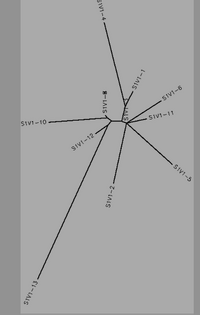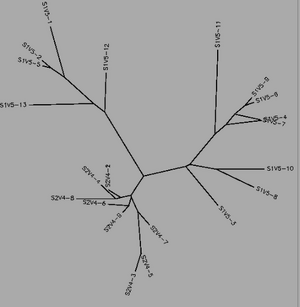BIOL368/F14:Chloe Jones Week 5
HIV Evolution project
Introduction
- Question: Is the diversity of the clones for subject 1 & 2 greater when alone, or when together?
- Hypothesis: I think the clones will be genetically more diverse as time progresses because subject 1 is a rapid progressor which based on the Markam at el. leads me to believe that the clones will diverge with time.
Methods & Results
- Used GenBank, nucleic acid data assocaited with the Markam et al. paper to create a FASTA formatted sequence that could be analyzed using the tools in Biology Workbench
- Compare the all the clones from all the visits from Subject 1 and 2 separately using the ClustalW tool in the Biology Workbench . Sequence the clones from subject 1 and 2 based on the first visit using the ClustalW tool. Sequence the clones from subject 1 and 2 based on the last visit using the ClustalW tool.The ClustalW tools sets up multiple sequence alignments where the number of nucleotide difference can be counted, termed (s) . The tool also allows for the generation of phylogenetic trees. Next, I used the Clusdist to tool to generate a distance matrix where the minimum and maximum differences can be calculated amongst the groups.











Table 1. Clustadist analysis of the sequences from Subject 1 all visits .
| Subject | Visits | S | Min Difference | Max Difference |
|---|---|---|---|---|
| Subject 1 | 3 | 93 | 0 | 35 |
b> Table 1.2 Clustadist analysis of the sequences from Subject 1, visit 1.
| Subject | Visit | S | Min Difference | Max Difference |
|---|---|---|---|---|
| Subject 1 | 1 | 26 | 0 | 14 |
Subject 1 had an immense amount of clone diversity progression based on Figure 1 and Figure 1.2. Initially the number of nucleotide differences(s) was 26 but by the end of all the visits the number had increased to 96. Also, the maximum difference had increased as well from 14 to 35, so that is evidence that there is greater variability amongst the clones as times progresses.
Table 2. Clustadist analysis of the sequences from Subject 2 all visits .
| Subject | Visits | S | Min Difference | Max Difference |
|---|---|---|---|---|
| Subject 2 | 3 | 36 | 0 | 14 |
Subject 2 clones were very similar to one another in the first visit. The maximum difference obtained from the Clustadist analysis was only that of 3. There were only 6 strains and they all branched out from the same branch on the phylogenetic tree. Also, the nucleotide differences amongst the clones on the first visit was only 5 (fig2.). The rate of divergence was small for Subject 2 as well because when all the visits were taken into account the max difference only went up to 14 ( Table 2.1).
Table 2.1 Clustadist analysis of the sequences from Subject 1 and 2, visit 1.
| Subject | Visit | S | Min Difference | Max Difference |
|---|---|---|---|---|
| Subject 1 & 2 | 1 | 30 | 0 | 14 |
Studying the viral strains of subject 1 & 2 for visit 1 show some similarities with the maximum difference only being 14. The max difference of 14 between both subjects is the same number as the maximum difference between the clones of the first visit of subject 1.
Table 3. Clustadist analysis of the sequences from Subject 2 , first visit
| Subject | S | Min Difference | Max Difference |
|---|---|---|---|
| Subject 1 | 5 | 1 | 3 |
Table 4. Clustadist analysis of the sequences from Subject 1 and 2 , last visit
| Subject | S | Min Difference | Max Difference |
|---|---|---|---|
| Subject 1 & 2 | 73 | 0 | 35 |
Subject 1 is having a huge impact on the data because it is diverging at a more rapid rate than Subject 2. Looking at Figure 3 and 4 it is clear that Subject 1 is genetically becoming more variable as time progresses. Initially, from the first visit the strains of clones are not as genetically related as that of Subject 2. Subject 1’s clones are further branched and rarely form clusters like that of Subject 2. Subject 1 has a greater genetic distance between the clones, which is an indicator that it has been a longer time since shared a common ancestor.
-pic of each phylogentic trees
-pic of each table
-pic of each multiple sequence alignment
-pic of each distance matrix
Conclusion
The first visit from both subject showed that they were genetically similar with the max difference between the subjects only being 14. However, as time progressed at the last visit the max difference was measured at 35. The difference from the first visit in comparison to the last visit had more then doubled. From the results it was observed that diversity was greater when the 2 subjects were measured together rather than alone. In the beginning , subject 1 (rapid progressor) had the same maximum difference together and when measured separate. However as time progressed, Subject 1 became more rapidly diverse and began to alter the data in favor of progression. Based on the phylogenetic trees Subject 2 clones are all within the same area which is indicative of a non progressor, whereas subject 1 tree shows plenty of divergence as time progresses which is indicative of a rapid progressor. As for this study goes it supports the ideas of Markham and his theory that people with a progressive from of HIV tend to have more diversity and divergence. This research project was very exclusive to only 2 subjects, so I think for future research it would be more accurate to compare more subjects and have more specific data points are clones that we are targeting. Some future studies could include studying the clones that were in the same subject and see how in particular they evolved over time. Also, study if diversity and the number of a particular clone plays a part in the difference progressiveness of HIV. The newly published papers that I obtained from Week 3 couldn't really be intergrated into my research topic because my topic was so specific and studied only two subjects
Electronic Lab Notebook
- Chloe Jones Week 2
- Chloe Jones Week 3
- Chloe Jones Week 4
- Chloe Jones Week 5
- Chloe Jones Week 6
- Chloe Jones Week 7
- Chloe Jones Week 8
- Chloe Jones Week 9
- Chloe Jones Week 10
- Chloe Jones Week 11
- Chloe Jones Week 12
- Chloe Jones Week 13
- Chloe Jones Week 15
Weekly Assignments
- Week 1 Assignment
- Week 2 Assignment
- Week 3 Assignment
- Week 4 Assignment
- Week 5 Assignment
- Week 6 Assignment
- Week 7 Assignment
- Week 8 Assignment
- Week 9 Assignment
- Week 10 Assignment
- Week 11 Assignment
- Week 12 Assignment
- Week 13 Assignment
- Week 15 Assignment
Class Journals
- Class Journal Week 1
- Class Journal Week 2
- Class Journal Week 3
- Class Journal Week 4
- Class Journal Week 5
- Class Journal Week 6
- Class Journal Week 7
- Class Journal Week 8
- Class Journal Week 9
- Class Journal Week 10
- Class Journal Week 11
- Class Journal Week 12
- Class Journal Week 13
- Class Journal Week 15
Chloe Jones 03:46, 15 October 2014 (EDT)Chloe Jones